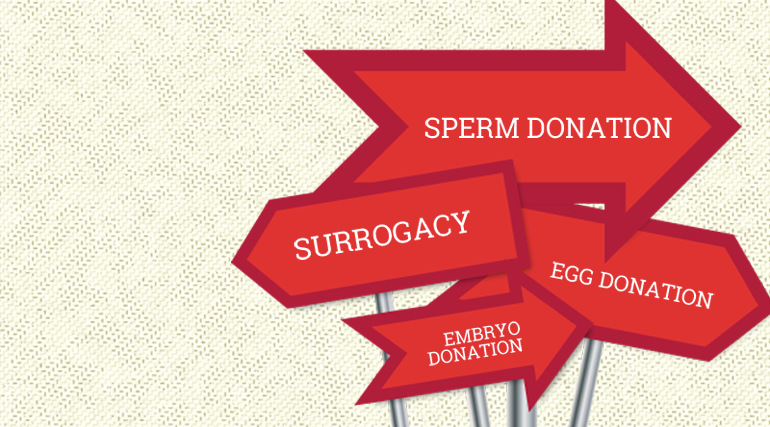DONOR SPERM OVERVIEW
[two_column_block style=”1″] [content1]
[/content1] [content2]
Single women, lesbian couples, heterosexual couples, and gay couples who don’t have viable sperm may use donor sperm.
[/content2] [/two_column_block]
[two_column_block style=”1″] [content1]
[/content1] [content2]
Each round of insemination with donor sperm can cost between $200 and $800; more than one round is often needed.
[/content2] [/two_column_block]
[two_column_block style=”1″] [content1]
[/content1] [content2]
The child will have a genetic link to the mother, or to neither parent if sperm donation was used with donor egg.
[/content2] [/two_column_block]
[two_column_block style=”1″] [content1]
[/content1] [content2]
When a woman undergoes treatment with ovulation induction medication and is inseminated, the incidence of multiple births is slightly higher than in unassisted conceptions. Multiple pregnancies can carry significant risk.
[/content2] [/two_column_block]
[two_column_block style=”1″] [content1]
[/content1] [content2]
If the intended mother can carry a pregnancy to term, she can experience pregnancy and delivery.
[/content2] [/two_column_block]
[two_column_block style=”1″] [content1]
[/content1] [content2]
The intended mother must monitor for ovulation, and may take ovulation-inducing medications. The intrauterine insemination (IUI) is generally quick and only mildly uncomfortable.
[/content2] [/two_column_block]
[two_column_block style=”1″] [content1]
[/content1] [content2]
Most sperm banks provide demographic, medical, and social background about the donors, and intended parents may select their donor.
[/content2] [/two_column_block]
[two_column_block style=”1″] [content1]
[/content1] [content2]
Most sperm donation from banks is anonymous, although some donors may agree to some future contact with child. Also, some donors may be friends or relatives of IPs.
[/content2] [/two_column_block]
[two_column_block style=”1″] [content1]
[/content1] [content2]
Donor may have agreed to future contact with child or child’s parents, but not all banks offer this option, and not all donors, when offered this choice, agree.
[/content2] [/two_column_block]
[two_column_block style=”1″] [content1]
[/content1] [content2]
Psychological consultation is recommended, but most programs don’t require it.
[/content2] [/two_column_block]
[two_column_block style=”1″] [content1]
[/content1] [content2]
If using donated sperm from a bank, usually no legal consult is needed. When the sperm is from a known donor, legal consultation is strongly recommended.
[/content2] [/two_column_block]
[vertical_spacing height=”100″]
[divider style=”6″]
DONOR EGG OVERVIEW
[two_column_block style=”1″] [content1]
[/content1] [content2]
Single women and heterosexual and lesbian couples may use donor eggs and carry the pregnancy themselves, or use a gestational carrier; single men and gay couples may use donor eggs with a carrier.
[/content2] [/two_column_block]
[two_column_block style=”1″] [content1]
[/content1] [content2]
Total fees for a donor egg cycle, including legal and medical expenses, typically range from $20,000 to $35,000.
[/content2] [/two_column_block]
[two_column_block style=”1″] [content1]
[/content1] [content2]
The child will have a genetic link to the father, or to neither parent if egg donation was used with donor sperm.
[/content2] [/two_column_block]
[two_column_block style=”1″] [content1]
[/content1] [content2]
The current guidelines of the American Society for Reproductive Medicine (ASRM) recommend single embryo transfers (SETs) when the egg donor is younger than 35. Multiple pregnancies can carry significant risk.
[/content2] [/two_column_block]
[two_column_block style=”1″] [content1]
[/content1] [content2]
If the intended mother can carry a pregnancy to term, she can experience pregnancy and delivery.
[/content2] [/two_column_block]
[two_column_block style=”1″] [content1]
[/content1] [content2]
If the intended mother is the recipient, she must undergo screenings, then take hormones and medications to align her cycle with the donor’s. The embryo transfer process is generally only mildly uncomfortable. If a frozen embryo cycle with donor eggs, the intended mother does not need to cycle with the donor.
[/content2] [/two_column_block]
[two_column_block style=”1″] [content1]
[/content1] [content2]
Egg donation matching programs provide demographic, medical, and social background about the donors, and IPs may select their donor. The selected egg donor must be available to cycle at a certain time.
[/content2] [/two_column_block]
[two_column_block style=”1″] [content1]
[/content1] [content2]
Intended parents may work with an anonymous or a known egg donor. There is sometimes the option to meet in person.
[/content2] [/two_column_block]
[two_column_block style=”1″] [content1]
[/content1] [content2]
Some donor contracts allow for future contact by the child (usually when the child is an adult), even if it is an anonymous donation.
[/content2] [/two_column_block]
[two_column_block style=”1″] [content1]
[/content1] [content2]
A psychological evaluation for the donor is required by almost all clinics. A psychological consultation is strongly recommended for IPs, and many clinics require this.
[/content2] [/two_column_block]
[two_column_block style=”1″] [content1]
[/content1] [content2]
A legal consultation, with independent representation for the parties, is strongly recommended, and many clinics require it.
[/content2] [/two_column_block]
[vertical_spacing height=”100″]
[divider style=”6″]
DONOR EMBRYO OVERVIEW
[two_column_block style=”1″] [content1]
[/content1] [content2]
Some embryo donation programs place restrictions on recipients’ marital status, religion, and sexual orientation. Embryo donors sometimes select the recipients, and may have personal preferences.
[/content2] [/two_column_block]
[two_column_block style=”1″] [content1]
[/content1] [content2]
A frozen embryo transfer (FET) ranges from $5,000 to $10,000. If the process is called embryo “adoption,” then an additional $5,000 to $8,000 for a program fee and home study is common.
[/content2] [/two_column_block]
[two_column_block style=”1″] [content1]
[/content1] [content2]
The child will not have a genetic link to either parent.
[/content2] [/two_column_block]
[two_column_block style=”1″] [content1]
[/content1] [content2]
American Society for Reproductive Medicine (ASRM) guidelines recommend embryo transfer limits based on the recipient’s age, prognosis, and the stage and quality of the embryos. Single embryo transfers (SETs) are generally recommended for women younger than 35. Some embryo donation programs prohibit multifetal pregnancy reduction. Multiple pregnancies can carry significant risk.
[/content2] [/two_column_block]
[two_column_block style=”1″] [content1]
[/content1] [content2]
If the intended mother can carry a pregnancy to term, she can experience pregnancy and delivery.
[/content2] [/two_column_block]
[two_column_block style=”1″] [content1]
[/content1] [content2]
If the intended mother is the recipient, she must undergo screenings, then take medications to prepare her uterus for the embryos. The embryo transfer process is generally only mildly uncomfortable.
[/content2] [/two_column_block]
[two_column_block style=”1″] [content1]
[/content1] [content2]
Some programs allow intended parents to select the donor embryo, some programs “match” the IPs with a donor embryo, and some programs have the donor family select the intended parents.
[/content2] [/two_column_block]
[two_column_block style=”1″] [content1]
[/content1] [content2]
Intended parents may work with anonymous or known embryo donors. There is sometimes the option to meet in person.
[/content2] [/two_column_block]
[two_column_block style=”1″] [content1]
[/content1] [content2]
Some donor contracts allow for future contact by the child (usually when the child is an adult), even if it is an anonymous donation.
[/content2] [/two_column_block]
[two_column_block style=”1″] [content1]
[/content1] [content2]
A psychological consultation is strongly recommended for intended parents and the donors, and most clinics require this.
[/content2] [/two_column_block]
[two_column_block style=”1″] [content1]
[/content1] [content2]
A legal consultation, with independent representation for the parties, is strongly recommended, and many clinics require it.
[/content2] [/two_column_block]
[vertical_spacing height=”100″]
[divider style=”6″]
GESTATIONAL SURROGACY OVERVIEW
[two_column_block style=”1″] [content1]
[/content1] [content2]
Single parents, heterosexual couples, and gay and lesbian couples may all work with gestational carriers.
[/content2] [/two_column_block]
[two_column_block style=”1″] [content1]
[/content1] [content2]
In the U.S., costs vary widely, from little to $50,000 to $100,000 (depending on carrier’s fee, program, legal, and medical expenses). In other countries, such as India, the cost ranges from $15,000 to $30,000, not including travel for the IPs.
[/content2] [/two_column_block]
[two_column_block style=”1″] [content1]
[/content1] [content2]
The child can have a genetic link to both parents, to the mother only (with donor sperm), to the father only (with donor egg), or to neither parent (with donor embryo or donor egg with donor sperm). In gestational surrogacy, the child is never genetically linked to the carrier.
[/content2] [/two_column_block]
[two_column_block style=”1″] [content1]
[/content1] [content2]
If the eggs used to create the embryo are from an egg donor or IP who is younger than 35, and if excess embryos can be frozen, the American Society for Reproductive Medicine (ASRM) recommends a single embryo transfer (SET). A carrier may decline to agree to a multiple embryo transfer or a multifetal pregnancy reduction. Multiple pregnancies can carry significant risk, and carriers generally receive additional payment for multiple pregnancies.
[/content2] [/two_column_block]
[two_column_block style=”1″] [content1]
[/content1] [content2]
A gestational carrier will carry the pregnancy to term.
[/content2] [/two_column_block]
[two_column_block style=”1″] [content1]
[/content1] [content2]
If the intended mother is using her own eggs, she will need to take hormones to stimulate multiple egg production, and the egg retrieval process involves minor surgery. None of this is necessary if using donor eggs or donor embryos.
[/content2] [/two_column_block]
[two_column_block style=”1″] [content1]
[/content1] [content2]
Most surrogacy centers provide demographic, medical, and social background about the carrier, and intended parents may select and meet their carrier.
[/content2] [/two_column_block]
[two_column_block style=”1″] [content1]
[/content1] [content2]
Intended parents select and almost always meet their gestational carrier, and often remain in close contact throughout the pregnancy.
[/content2] [/two_column_block]
[two_column_block style=”1″] [content1]
[/content1] [content2]
Intended parents and the gestational carrier may or may not decide to have ongoing contact.
[/content2] [/two_column_block]
[two_column_block style=”1″] [content1]
[/content1] [content2]
A psychological consultation and an evaluation are almost universally required for the intended parents and the carrier.
[/content2] [/two_column_block]
[two_column_block style=”1″] [content1]
[/content1] [content2]
Legal consultation, with independent representation for the parties, is almost universally required.
[/content2] [/two_column_block]



